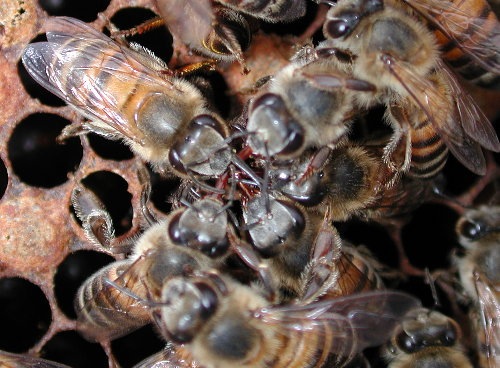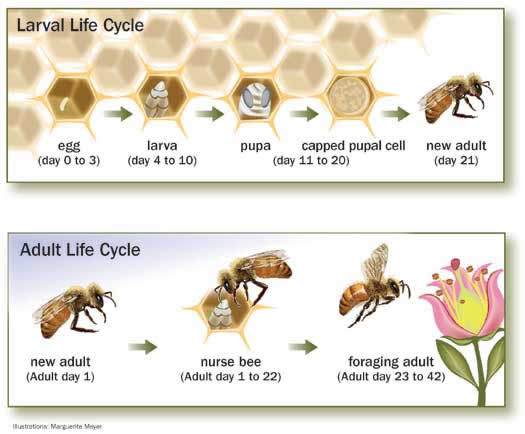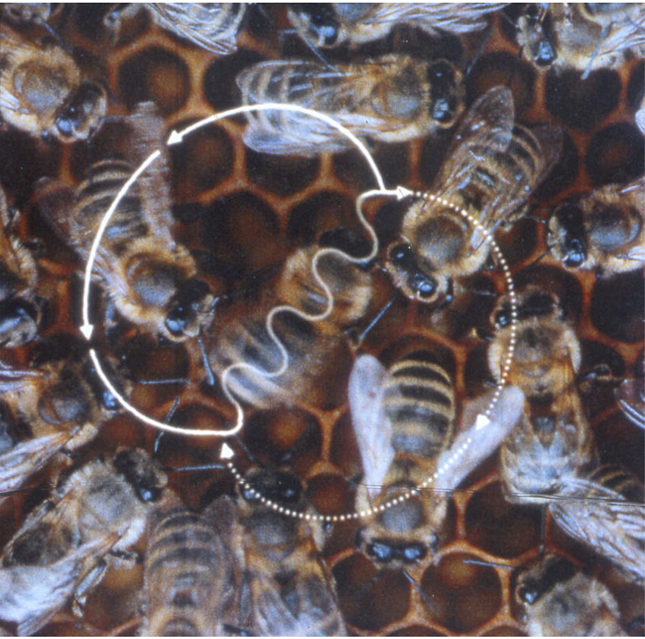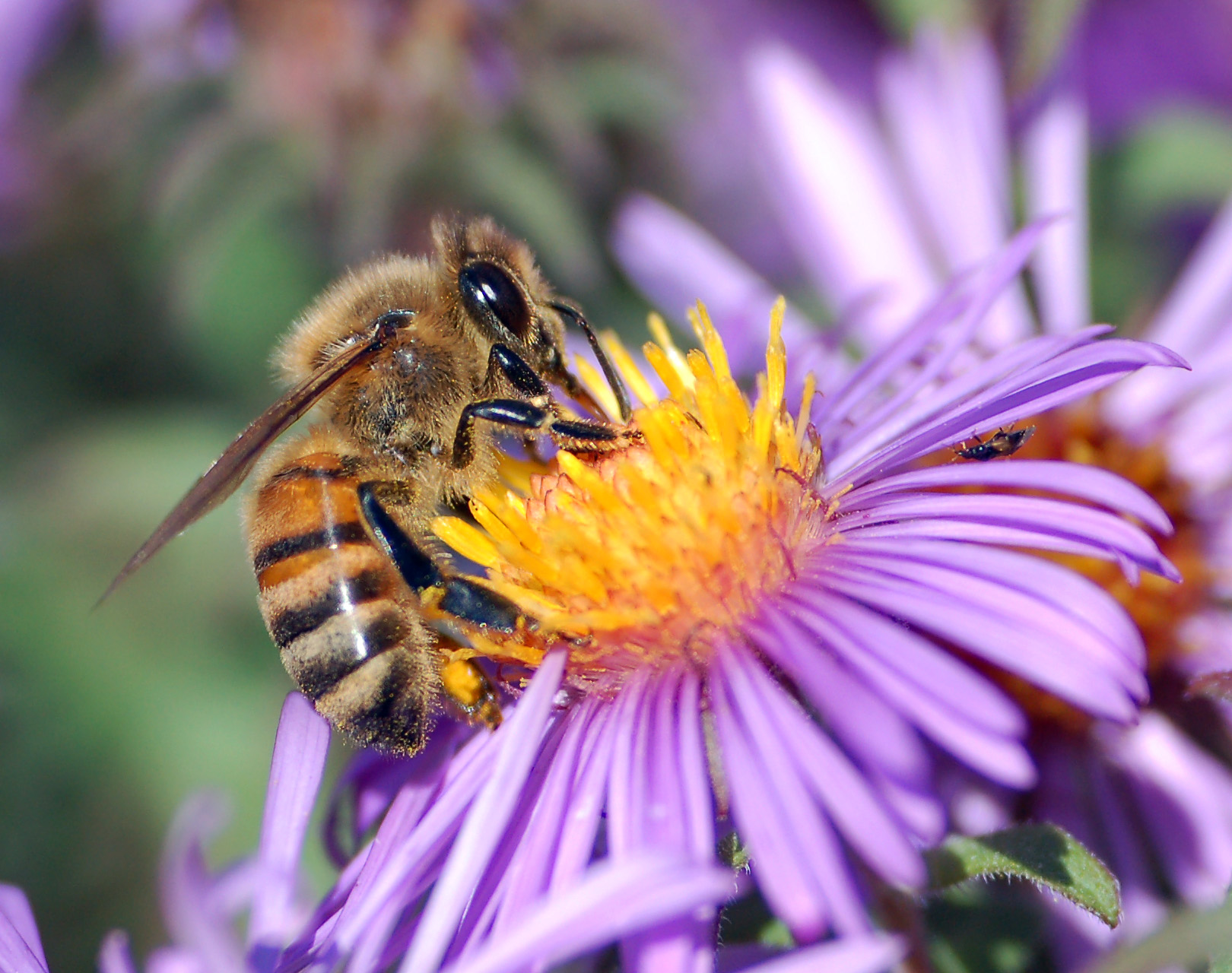Hive Behavior in Honey Bees
James Holland and Theresa Steele
Biology 342
Workers

Worker bees communicating using pheromones and their sensitive antennae. From adventures in bee land.
The worker caste is the most populous caste within the hive, with up to 50,000 workers for a single queen in a single hive (Galbraith et. al 2015). These aptly named females are responsible for carrying out most of the labour within the hive -- from cleaning and building, to rearing broods, to foraging and defending the hive (Winston 89).
Birth of a worker:
Workers begin life as a diploid egg laid by a queen in a wax cell, where they develop for about 21 days, depending on climate conditions (Winston 51). Diploid eggs are capable of being cultivated into either workers or queens (Winston 66). Larvae that will become workers are fed “brood food”, a mixture of food containing mandibular gland secretions, hypopharyngeal gland secretions, and protein-rich pollen, in a 2:9:3 ratio, while eggs that develop into queens are fed “royal jelly”, which is mostly mandibular and hypopharyngeal secretions in a 1:1 ratio, with a lot of sugar -- see our page on queens for more information (Winston 67). Based on this diet, the brains of developing workers grow more slowly than those of queens, and worker larvae will express fewer neural growth factors (Moda 2013). For their first 10 or so days after emerging from their cells, workers must consume plenty of protein, primarily by eating pollen (and brood food, to a lesser extent), to finish developing a hard outer shell (Winston 54). Once fully formed, workers can live anywhere from 15 to 100 days, with the average life expectancy for bees born in the summer to be around 15-38 days, while winter bees live around 30-60 days (Winston 55).

The worker bee reproductive life cycle. Image from pollinator.org.
The Bee-siness of workers:
Throughout their lives, most workers perform a variety of tasks for the benefit of the hive. In general, workers spend their first few days of life performing tasks within the hive, and as they age, gradually transition to roles that take them farther from the hive (Winston 91). This development takes them from cell cleaning and capping in their first few days, to tending the brood and queen, to food handling and comb preparation in their teen days, to guarding and foraging for the hive (Winston 93). As workers transition from role to role, their levels of Juvenile Hormone (JH) rise, peaking in workers who perform tasks outside of the colony regardless of age (Huang 1993). Similarly, as workers age, their hypopharyngeal gland (a gland used to secrete the brood food and royal jelly fed to larvae) gradually disappear (Robinson 1992). However, this developmental trajectory is influenced by genetic and environmental factors, as well as the bee’s age, and under appropriate circumstances can even be reversed. Queen Mandibular Pheromone (a contact pheromone secreted from the queen’s mandibular gland) has been shown to delay the increase in JH titer in workers, as well as the development of foraging behavior, possibly as a method of controlling caste structure in queenright colonies (Galbraith et al. 2015, Pankiw et al. 1997).
A foraging worker collecting pollen. From Wikipedia.
Workers’ behavioral development is also influenced by the labor division that already exists within the colony. Developing workers in colonies from which all foragers have been removed have been shown to more rapidly develop foraging behaviors, high JH titer levels, and lose their hypopharyngeal glands than controls (Huang et al. 1996). In the opposite case, when all of the juvenile workers are removed from a hive, foraging bees revert to nursing and hive maintenance behaviors, with an associated drop in JH titer, and a regrowth of hypopharyngeal glands (Huang et al. 1996). However, workers’ developmental rates have been shown to be influenced by genetics, and workers that specialize in hive defense are on average 10 days younger than foragers, though they display similar physiology and levels of JH titer. The plasticity of the worker phenotype allows the hive to respond to likely disruptions to the hive’s equilibrium, improving its fitness as a collective.
Worker Reproduction :
Although workers are female, they are incapable of mating and are for the most part not reproductive. Worker’s reproductive dormancy has been shown to be enforced by the presence of a queen -- more specifically, by the QMP she releases-- as well as the presence of a brood (Hoover et al 2003, Barron et al 2001). Consequently, though some workers do have relatively large ovaries, they generally do not lay eggs while a queen is pr esent, and workers who do lay eggs may be ‘policed’ by other workers -- as bees are haplodiploid, the male offspring of the queen is more related to a given worker than the male offspring of her sister, and consequently, workers eat any eggs they come across not laid by the queen (See Hive Dynamics ) (Barron et al 2001). This policing, and the suppressing effect of QMP on worker reproduction, serves to check the reproduction of those who would 'cheat' the eusocial system, and keeps the relatedness of the hive high, improving the reproductive success of the hive and of the individual.
Worker Communication :

A schematic of a waggle dance. Image from wikipedia.
The most well known form of bee communication undoubtedly the “waggle dance” studied by von Frisch in the mid 20th century. In these dances, a foraging worker returns to the hive from a newly found food source, and performs “waggling runs” along the comb at a specific angle to gravity -- an angle that corresponds to the angle of their food source relative to the sun-- and will dance longer the farther from their food source they get (Dyer 2002). Workers will be more likely to dance the larger and nearer their food source is, and the more in need of food the hive is -- a measurement indicated by the speed with which she is met by other workers in the hive (Dyer 2002). In doing waggle dances selectively for optimal food sources, the worker is minimizing the cost to the hive --the travel and search time for each individual --, and maximizing the benefit --the potential total pollen yeild --, so this behavior serves to keep the hive's foraging as efficient as possible. The waggle dance is a common behavior in many Apis sub-species, and based on its various styles, it is thought the dance evolved from a dance done in the open air (Engel and Schultz 1997). Workers may also perform a “trembling dance”, indicating the need for increased food-receiving bees, a “round dance” indicating a nearby food resource, or a “DVAV dance” associated with swarming behavior and increasing overall hive activity (see Hive Dynamics page for more information on swarming), among others (Winston 161). Workers also use pheromones to communicate with each other, as markers for food sources, alarm, and kin recognition, among other reasons (Winston 130).
